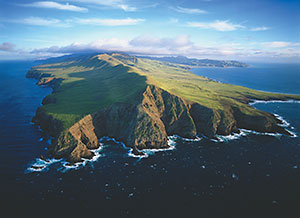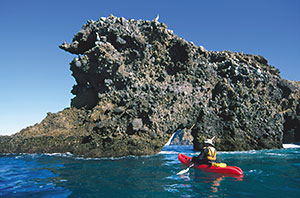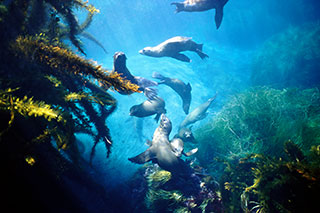SOJOURN ON SANTA CRUZ
I’m addicted to the stillness of secluded isles and the sound of virgin surf. The opportunity to trek through unfamiliar landscapes never fails to act on me as a powerful lure. This has driven me to explore and, under its spell, I’ve gone eye to eye with white sharks, swum with sea lions, dined on the nectar of Mother Nature, and wielded a machete through thick balmy jungle. Amazingly, such a siren call sounds from just off our coast. They call it the “California Galapagos.” And like its famous South American cousin, it is home to plants and animals found nowhere else on Earth. Welcome to Santa Cruz Island. Close to the mainland yet worlds apart, Santa Cruz is the largest island off the west coast at 96 square miles. It is four-times the size of Manhattan. Here, evolution proceeds independently, fostering the development of 60 endemic species, including the island scrub jay, island fox and the island deer mouse.
Amazingly, such a siren call sounds from just off our coast. They call it the “California Galapagos.” And like its famous South American cousin, it is home to plants and animals found nowhere else on Earth. Welcome to Santa Cruz Island. Close to the mainland yet worlds apart, Santa Cruz is the largest island off the west coast at 96 square miles. It is four-times the size of Manhattan. Here, evolution proceeds independently, fostering the development of 60 endemic species, including the island scrub jay, island fox and the island deer mouse.Santa Cruz’s varied hiking opportunities and secluded coves and beaches is also eerily reminiscent of neighboring San Miguel Island, where I spent time exploring the remote wilderness in spite of biting winds and impenetrable fog. And like Miguel, Santa Cruz is characterized by miles of spectacular trails, rich kelp forests teeming with life and historical landmarks depicting early eighteenth century settlers. I couldn’t wait to get there…
 On board the Islander, a 64-foot catamaran owned and operated by Island Packers, the authorized concessionaire to the Channel Islands National Park, we zip across the Santa Barbara channel as pods of common dolphin ride our bow, breaking the surface just long enough for me to appreciate their streamlined bodies and incredible sense of intelligence. Ahead, a tranquil isthmus known as Scorpion Anchorage greets us. The surreal landscape with its weathered and barnacle-encrusted Scorpion Pier recalls the memoirs of former ranch superintendent Clifford McElrath when he wrote of how the ranchers would adapt to the difficulties of isolated island life through self-reliance and by “learning to make do with what they had.” The catamaran eases forward and rests momentarily against the age-old structure as I disembark with a large hiking pack strapped to my back. Accompanying me is a handful of day-trippers who will reconvene at four-o’clock for the return to Ventura Harbor. I will spend the night.
On board the Islander, a 64-foot catamaran owned and operated by Island Packers, the authorized concessionaire to the Channel Islands National Park, we zip across the Santa Barbara channel as pods of common dolphin ride our bow, breaking the surface just long enough for me to appreciate their streamlined bodies and incredible sense of intelligence. Ahead, a tranquil isthmus known as Scorpion Anchorage greets us. The surreal landscape with its weathered and barnacle-encrusted Scorpion Pier recalls the memoirs of former ranch superintendent Clifford McElrath when he wrote of how the ranchers would adapt to the difficulties of isolated island life through self-reliance and by “learning to make do with what they had.” The catamaran eases forward and rests momentarily against the age-old structure as I disembark with a large hiking pack strapped to my back. Accompanying me is a handful of day-trippers who will reconvene at four-o’clock for the return to Ventura Harbor. I will spend the night.Santa Cruz, protected from human disturbance, is rich in wildlife. Darting harbor seals, diving cormorants and squawking gulls watch our progress like judges on the high bench. A brown pelican gallantly stands guard on a craggy peak staring. Silently the bird takes wing as if granting us permission to come ashore. While the others picnic on the beach, I follow the quarter-mile trail to base camp which meanders inland from the rock-strewn shoreline. The radiant sun warms me as I traverse the same path as did the blacksmiths, sheep ranchers and sea captains of yesteryear. The sounds of pounding surf and seabirds fade with every stride as I saunter past the historic bunkhouse, ranch house and rusted tractors at Scorpion Ranch. Under the direction of Justinian Caire beginning around 1880, a variety of agricultural and ranching endeavors were developed in an effort to create a self-sufficient operation on the island. Sheep, cattle, horses and pigs were raised while hay, vegetables, and over a dozen varieties of grapes were grown, in addition to almond, walnut and other fruit and ornamental trees. Built in 1887, the two-story Scorpion ranch house, and later, the wooden bunkhouse (1918), were home to ranch hands that tended the flocks of sheep, cattle and crop fields.
 My plan is to explore the remote island by foot and kayak, but first I must set up camp before the sun dips over the horizon. I come across the first of two campsites beneath a dense grove of 100-year-old blue-gum eucalyptus trees which emit an invigorating aroma. Each site offers plenty of shade, picnic tables and fresh drinking water (note: I advise winter campers not to set their tent directly under the trees as a constant bombardment of falling acorns will produce a sleepless night).
My plan is to explore the remote island by foot and kayak, but first I must set up camp before the sun dips over the horizon. I come across the first of two campsites beneath a dense grove of 100-year-old blue-gum eucalyptus trees which emit an invigorating aroma. Each site offers plenty of shade, picnic tables and fresh drinking water (note: I advise winter campers not to set their tent directly under the trees as a constant bombardment of falling acorns will produce a sleepless night).With the tent erected and gear put away, I load up a day pack with trail mix and bottled water and head up the lonely canyon towards Cavern Point and Potato Harbor. Along the way, I come across walls of white, chalky rock. This is diatomaceous earth, derived from minute single-cell sea plants called diatoms. As these plants died, their skeletons settled into the marine sediment and later recrystallized as a dense form of hard rock.
As the cool, salty mist fills the air, I arrive at Cavern Point. The steep, rugged volcanic cliff is home to a large breeding center for sea- and shore birds. Isolation and freedom from predators, including man, and the abundance of food in the cold, nutrient-rich ocean waters, makes this an ideal place for marine birds to breed and rear their young. Traversing a bit further, past fields of lemonade berry, monkey flower and wild cucumber, I reach the overlook at Potato Harbor, named for its oval potato shape. From the panoramic overlook, I have a magnificent view to the west and the rest of Santa Cruz Island.
With the setting sun transforming the cobalt sky to crimson and gold, I turn back and make a final hike, ascending Smugglers Road. Escorted by hummingbirds and circling ravens, the steep and strenuous trail leads to Smugglers Cove, named because there was wide spread smuggling around the back side of the island by sea otter traders and others, known as contrabandista during both the Spanish and Mexican years. Unfortunately, with the diminishing light, I have to retreat to camp.
The next morning, after a cup of instant coffee and bowl of Muselix, I head for the water’s edge to meet kayaking guide, Garrett Kababik, from Paddle Sports of Santa Barbara, central coast's premier kayak center. A former New Yorker who left the Big Apple for sunny skies and offshore isles, the 24-year-old adventurer has an exciting trip in store for us.
After a brief tutorial on the basics of kayaking, we take to the surf, equipped with wetsuits, life vest, helmet and self-draining Ocean Kayak Sit-on-Tops. After a short paddle, we come upon the island’s craggy cliffs and mysterious sea caves, some of which are large enough to enter. Keeping a wary eye out for unfriendly tanker swells which can fill the inner cavity and wreak havoc on those who enter, we paddle through a thick layer of sea mist and into Painted Cave. The rock ceiling passes overhead as we find ourselves deep into the extraordinary formation. Daylight is all but gone, replaced with the fluorescent illumination from our spot lights. Our voices ricochet off the volcanic walls as the surging tide envelopes us. It’s an eerie yet exhilarating feeling – it reminds me of the formidable sea caves at Walt Disney’s Pirates of the Caribbean but without the pirates. Moments later, we exit, emerging into the sunlight, unscathed. We work our way up the coastline exploring the pristine marine environment from the water. Eventually, we will paddle to Potato Harbor and back, dipping in and out of at least a half-dozen sea caves, each with their own unique shape and character.
With the silhouette of the Islander approaching against the sapphire sky, it’s time to paddle back to shore and strike camp before returning to the mainland. As I board the catamaran and silently watch the shoreline recede, the playful dolphins return as if escorting us back home. It is an image rich in adventure that will stay with me a long time. Like a great courtesan, Santa Cruz has revealed its treasures slowly, holding something in reserve for the next encounter.